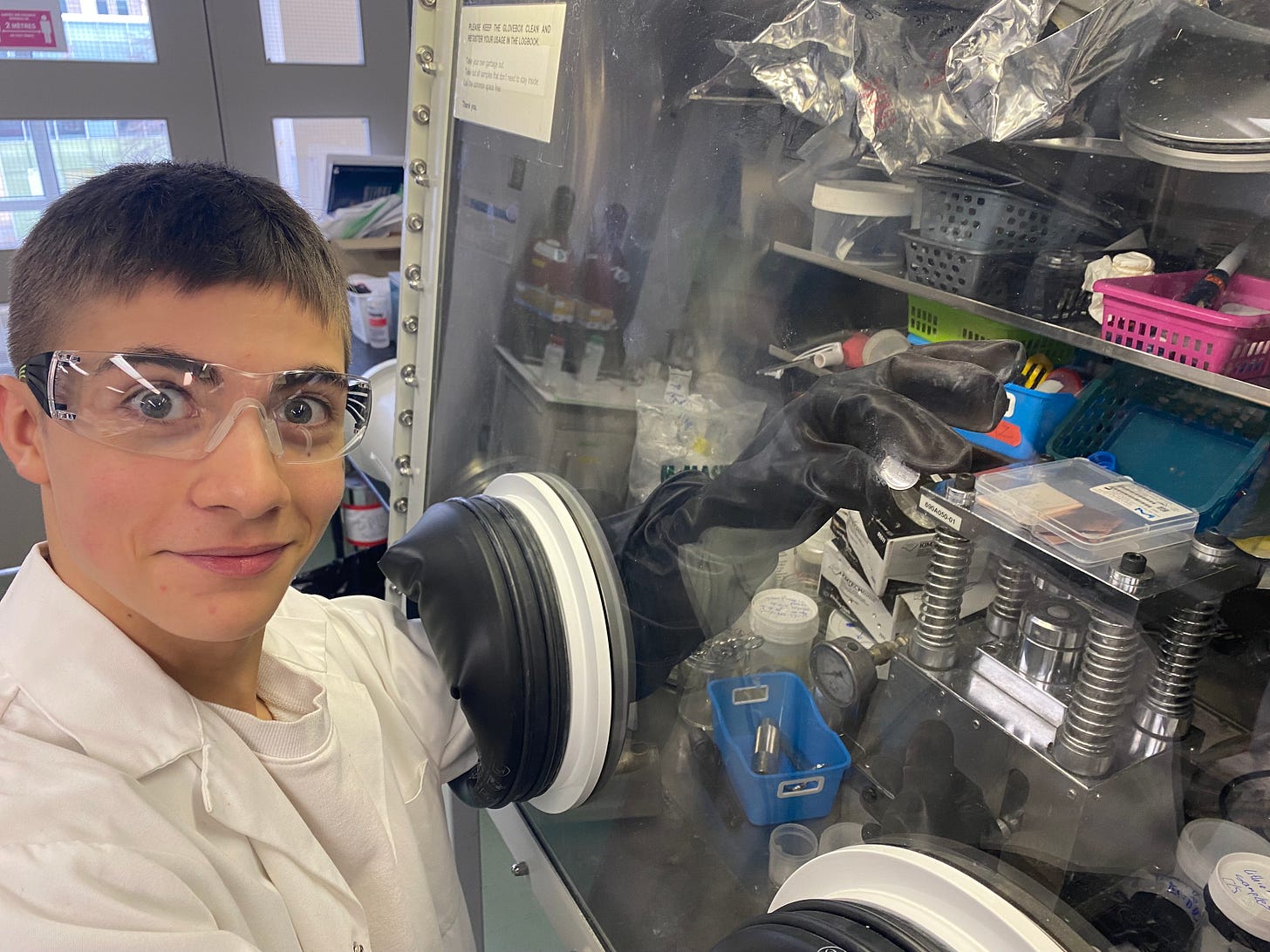Time for an Update! This December month was a whole lot of fun. Let’s jump into the world of batteries again to see where I’ve gotten so far.
Lab experience
My last month of the year was very exciting. One of the most memorable experiences I had this month was going to a lab to build a lithium-ion battery.
This experience helped me apply my knowledge as I was able to see what actually happens in the research space. I can’t thank enough UQAM and professor Steen the researcher who gave me this opportunity.
This was not only fun and exciting but it taught me about 3 problems that the battery world is facing.
Making batteries, meaning getting the materials, mixing the chemicals together, building the battery, and testing the battery takes time.
Usually, researchers make one battery a week, 2 if it’s a really good week, which means about 52 batteries a year. 52 might seem big but for researchers, it’s a pretty small sample size.
Plus lack of precision can make a battery malfunction which means you might not get 52 working batteries a year. This is why breakthroughs in the battery research space take a lot of time.
When batteries do malfunction it’s hard to know why. This is because batteries are chemical processes, meaning everything that happens in one is at the atomic scale.
So knowing exactly what went wrong is a challenge when you're dealing with subatomic particles. This combined with the fact that there is a small sample size of batteries made in the lab makes research even slower.
Side note: The Ph.D. student I met was trying to solve this problem by using microscopes to better understand the reactions taking place.
Supply chain issues, when asking professor Steen what was the biggest limiting factor for batteries. He responded with the supply chain. After investigating a bit more, I understand why.
Getting the materials for batteries is expensive and takes time. There is not enough infrastructure for it yet and people are scrambling to find new lithium mining sites. Yet the demand for lithium-ion batteries increases exponentially every year.
Plus there are geopolitical issues involved as well, China and Russia supply a lot of lithium to North America and Europe.
These 3 problems compound with each other making it hard to make breakthroughs in the lithium-ion battery space.
Startup ideas
Recently I’ve been reading Paul Graham’s essays on startups. If you’re interested in start-ups and entrepreneurship I recommend you read them. I’ll link them here:
For those who don’t know who Paul Graham is, he is a successful entrepreneur that became rich off of his startup “Viaweb”. He also founded “YCombinator” a company that invests in startups and helps them get off the ground.
In one of his essays, he debunks one of the biggest myths in the world of startups: good startups succeed because of brilliant ideas. I believed this as well. I used to think to myself “I wish I had a good idea, but I just don’t have any good ones for startups”. Even when I had a good idea I would shoot it down saying “Is that really the next Google or Microsoft?”.
What I thought, was actually furthest from the truth. Good startups don’t usually start with million-dollar ideas. Good startups start with flawed questions, that iterate over time to become innovative ideas.
Google’s question was “What if search engines didn’t suck?”. There were already search engines at the time. Yahoo was dominating the search space.
But they must have asked themselves, is Yahoo the search engine of the future? Is everyone going to be using Yahoo in the next 20 years, or are there things we can innovate?
After that, they had to iterate constantly from prototype to product. But Google wasn’t just some brilliant idea that just magically formed into the billion-dollar company it is today.
So I had to start asking myself what is my question. What can I ask myself to get the wheels of innovation spinning and generate ideas for the battery space?
I think I’ve narrowed my question down to…
What if we didn’t need to mine expensive materials that harm the environment to make batteries?
I’ve created parameters for what this sort of battery would look like:
It should be way cheaper
Have high energy density
Have some longevity
Use materials that aren’t harmful to the environment, and that don’t have supply chain issues.
In January I’m going to start looking into biological batteries as they wouldn’t use materials that are harmful to the environment.
Goals for this Month
Finish writing battery article
Finish writing lab experience article
Read research papers on lithium-ion batteries
Read research papers on biological batteries
Goals for the New Year
This year 2022 I grew so much, from being an A.I. enthusiast to a battery fanatic. My main goal for the new year is to grow as much as possible and to create as many opportunities as I can for myself.
This quote by Ben Franklin perfectly summarizes my feelings going into the new year:
“If you love life, don't waste time, because time is what life is made of.”
I’m going to waste less time on the things that don’t matter (youtube, stressing over exams, wasting energy on meaningless tasks) and focus on the things that do matter (family, friends, making an impact).
I’m jumping into the new year with high hopes and big expectations. Let’s see where it goes.
See you next month!



